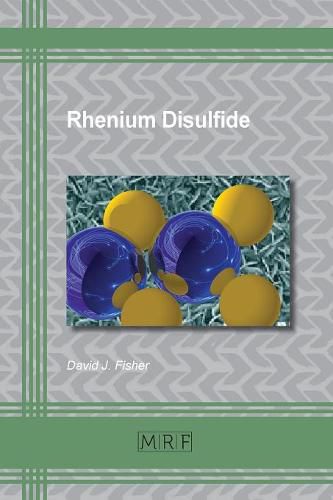Readings Newsletter
Become a Readings Member to make your shopping experience even easier.
Sign in or sign up for free!
You’re not far away from qualifying for FREE standard shipping within Australia
You’ve qualified for FREE standard shipping within Australia
The cart is loading…






This title is printed to order. This book may have been self-published. If so, we cannot guarantee the quality of the content. In the main most books will have gone through the editing process however some may not. We therefore suggest that you be aware of this before ordering this book. If in doubt check either the author or publisher’s details as we are unable to accept any returns unless they are faulty. Please contact us if you have any questions.
All you want to know about Rhenium disulfide in an easy to read condensed format. Rhenium disulfide, especially in low-dimensional form, is a subject of lively research into its electronic and optical properties. The field of twodimensional materials such as graphene and its analogues has been growing very rapidly. This class of materials also includes rhenium disulfide and rhenium diselenide, which belong to the transition-metal dichalcogenide family. Due to their reduced crystal symmetry, they exhibit distinct electrical and optical characteristics along certain in-plane crystal directions.
The group-VI members such as molybdenum and tungsten are the most typical ones, but group-VII rhenium disulfide has been attracting most attention of late because of its unusual structural, electro-optical and chemical properties; especially an indirect-to-direct band-gap transition which occurs when thinned down from bulk to monolayer. The group-VI transition-metal dichalcogenides have a 1H, 2H, 3R or 1T structure, whereas ReS2 has a distorted 1T structure which imparts an in-plane anisotropy to its physical properties. Few other materials (black phosphorus, ReSe2, TiS3, ZrS3) exhibit such an in-plane structural anisotropy. This makes ReS2 unique among the transition-metal chalcogenides. Atomically thin rhenium disulphide is characterized by weak interlayer coupling and a distorted 1T structure, which leads to the anisotropy in optical and electrical properties. It also possesses structural and vibrational anisotropy, layer-independent electrical and optical properties and metal-free magnetism. In these respects, it differs from group-VI transition-metal dichalcogenides such as MoS2, MoSe2, WS2 and WSe2. It is already being used in solid-state electronics, catalysis, energy storage and energy-harvesting applications.
$9.00 standard shipping within Australia
FREE standard shipping within Australia for orders over $100.00
Express & International shipping calculated at checkout
This title is printed to order. This book may have been self-published. If so, we cannot guarantee the quality of the content. In the main most books will have gone through the editing process however some may not. We therefore suggest that you be aware of this before ordering this book. If in doubt check either the author or publisher’s details as we are unable to accept any returns unless they are faulty. Please contact us if you have any questions.
All you want to know about Rhenium disulfide in an easy to read condensed format. Rhenium disulfide, especially in low-dimensional form, is a subject of lively research into its electronic and optical properties. The field of twodimensional materials such as graphene and its analogues has been growing very rapidly. This class of materials also includes rhenium disulfide and rhenium diselenide, which belong to the transition-metal dichalcogenide family. Due to their reduced crystal symmetry, they exhibit distinct electrical and optical characteristics along certain in-plane crystal directions.
The group-VI members such as molybdenum and tungsten are the most typical ones, but group-VII rhenium disulfide has been attracting most attention of late because of its unusual structural, electro-optical and chemical properties; especially an indirect-to-direct band-gap transition which occurs when thinned down from bulk to monolayer. The group-VI transition-metal dichalcogenides have a 1H, 2H, 3R or 1T structure, whereas ReS2 has a distorted 1T structure which imparts an in-plane anisotropy to its physical properties. Few other materials (black phosphorus, ReSe2, TiS3, ZrS3) exhibit such an in-plane structural anisotropy. This makes ReS2 unique among the transition-metal chalcogenides. Atomically thin rhenium disulphide is characterized by weak interlayer coupling and a distorted 1T structure, which leads to the anisotropy in optical and electrical properties. It also possesses structural and vibrational anisotropy, layer-independent electrical and optical properties and metal-free magnetism. In these respects, it differs from group-VI transition-metal dichalcogenides such as MoS2, MoSe2, WS2 and WSe2. It is already being used in solid-state electronics, catalysis, energy storage and energy-harvesting applications.